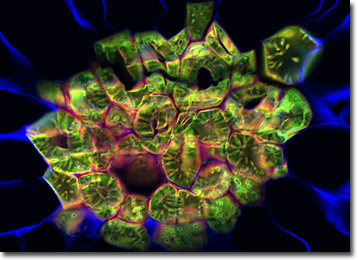 |
 |
 |
|
||||||||||||||||||||||||
 | ||||||||||||||||||||||||
 | ||||||||||||||||||||||||
 | ||||||||||||||||||||||||
Confocal Microscopy Image Gallery
Plant Tissue Autofluorescence Gallery
Pear Fruit Sclereids
Several species of trees belonging to the genus Pyrus and the sweet fruits they typically bear are known as pears. Pear trees are native to Europe and Asia, but are cultivated in temperate regions around the world.

The trees may grow to about 50 feet in height and produce numerous small, attractive flowers that are most often white, but may also be pink or yellow hued. Some varieties of the tree, especially those that are nonfruiting, are often utilized as ornamentals. More commonly, however, the trees are grown specifically for fruit production, which generally requires four to seven years to begin occurring at a desirable level.
The pear fruit is commonly eaten fresh or canned, and in several countries is very popular for the production of perry, a drink made by fermenting pear juice. In the United States, pears most commonly exhibit an elongate form that is bulbous at its unattached end, but in other countries rounder varieties are also regularly grown. The texture of the pear, which is a type of pome, is characteristically gritty, a quality that is related to the presence of special cells called sclereids or stone cells. Sclereids are variously shaped sclerenchyma cells with thick, lignified walls that function in providing structural support and strength to tissues.
Contributing Authors
Nathan S. Claxton, Shannon H. Neaves, and Michael W. Davidson - National High Magnetic Field Laboratory, 1800 East Paul Dirac Dr., The Florida State University, Tallahassee, Florida, 32310.
